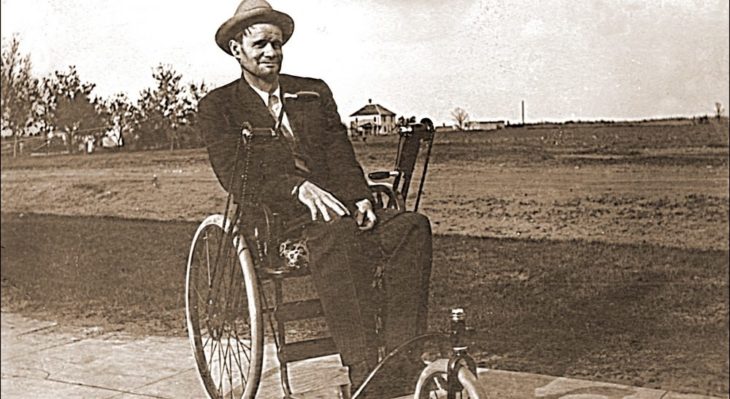A Brief History of the Wheelchair

We are unable, with any degree of certainty, to ascertain any firm evidence as to when wheelchairs were first used. However, what can be in no doubt is that because accidents and illnesses have always been with us, it is very likely that the very first wheelchairs would have been “invented” 5,000/6,000 years ago.
The wheelbarrow, which was invented in China during the Second/Third Century AD, was certainly used for transporting the disabled and is probably the oldest documented evidence of chairs that are wheeled.
The first specific evidence of a wheelchair can be seen by way of an image engraved in China in AD 525. For the next thousand years or so there appears no further documentary proof until an artist drew a sketch of Phillip II of Spain seated in a chair specifically made for the purposes of disabled mobility. This chair had small wheels affixed to the end of the chair legs and also included not only a platform for the Spain King’s legs but also a backrest that could be adjusted. At the time, the wheelchair was actually named an “invalid’s chair”.
King Phillip’s wheelchair was not able to be self-propelled, which probably comes as no surprise insofar that he would have relied on the pushing abilities of one of his servants. We have to wait a further 80 years before the invention of a wheelchair that could be independently propelled. Steven Farfler, a 22-year-old disabled watchmaker, built, in 1655, what seems a very stable chair which he mounted on a 3-wheeled chassis. Mr Farfler attached handles on both sides of the front wheel in order that he was able to self-propel himself.
We have to wait for another 130 years for the next major wheelchair development when, in 1783, John Dawson of Bath, (a Spa town 200 miles west of London, where many paraplegics travelled to both drink and bathe in the spa waters), invented a wheelchair that he actually named after his hometown. The ‘Bath’ chair was designed with two large wheels at the rear and a smaller wheel at the front. The disabled occupant would steer the wheelchair by a stiff handle and Dawson’s ‘Bath’ chair outsold all other mobility wheelchairs for the first 30/40 years of the 19th Century. Many different versions of the ‘Bath’ chair were made and some of them even had glass fronts. The popular models included open versions and hooded examples, but in all cases they had to be either pushed or pulled by a donkey or a small horse. It has to be said that Dawson’s wheelchair was not particularly comfortable and throughout the second half of the 19th Century many wheelchair manufacturers made many improvements. Comfortability for the disabled user became the vital factor in later wheelchair models. Convertible wheelchairs with both adjustable footrests and reclining backs became the norm.
In 1869 a patent was taken out for a wheelchair which was the forerunner of the wheelchairs we know today that had large wheels at the back that could be self-propelled. This proved somewhat inconvenient when the chair ran through muddle puddles but the problem was quickly solved a few years later when a second rim with a smaller circumference was welded within the framework) with smaller wheels at the front. The wheelchairs became far less bulky and infinitely more comfortable.
By the commencement of the 20th Century many new developments had been invented, including moveable arms and footrests. In 1916, good old British engineers invented the first wheelchairs with motors although, like today, the vast majority still used manual versions.
The main problem with wheelchairs was the very fact that they were very difficult to both transport and then store until, in 1932, Harry Jennings, an engineer, came up with the wondrous idea of a folding, tubular steel version of which very little change to the ubiquitous design we now have today has been made.
Jennings built it specifically for his disabled friend, Herbert Everest, who needed a wheelchair that could easily be transported in a car. Together, in 1933, they founded Everest & Jennings, and that company became a virtual monopoly in the wheelchair industry for decades. Indeed, the US Department of Justice actually charged the company with rigging the price of wheelchairs and the case was finally settled on the doorsteps of the Court.
The main reason for changes in wheelchair design was because of the introduction of the motor car and to get the wheelchairs into the backs of the cars.
Bizarrely, electrically powered wheelchairs were generically named ‘electric chairs’ until the advertising companies quickly realised that these chairs were not of the execution variety!
The latest wheelchair innovations are, to say the least, exciting and if someone from the 18th or 19th Century could see a perfectly balanced wheelchair standing up on two wheels they wouldn’t believe their eyes. This particular chair, called the ‘I-Bot’ can not only rise up on two wheels but even if somebody tries to push it off-balance it rectifies itself. Indeed, it can hold its balance better than a human. However, the I-Bot does come with a disadvantage whereby the price is closer in feel to a luxury car (£33,000) and thus is not quite within everybody’s reach!
Undoubtedly, we can be more than sure that wheelchairs of the future will be very unlike those that are currently in production. It has been suggested that in the future there will be wheelchairs controlled by neurological impulses from the brain. Indeed, scientists in Spain are currently working on an interface which will allow users to control the wheelchairs.

